Red Hand of Ulster
The Red Hand of Ulster (Irish: Lámh Dhearg Uladh) is an Irish symbol used in heraldry[1] to denote the Irish province of Ulster. It is an open hand coloured red, with the fingers pointing upwards, the thumb held parallel to the fingers, and the palm facing forward. It is usually shown as a right hand, but is sometimes a left hand, such as in the coats of arms of baronets.
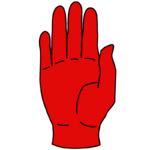
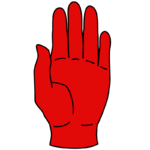
Historical background
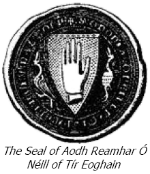
The Red Hand is rooted in Gaelic culture and, although its origin and meaning is unknown, it is believed to date back to pagan times.
The Red Hand is first documented in surviving records in the 13th-century, where it was used by the Hiberno-Norman de Burgh earls of Ulster.[2] It was Walter de Burgh who became first Earl of Ulster in 1243 who combined the de Burgh cross with the Red Hand to create a flag that represented the Earldom of Ulster and later became the modern Flag of Ulster.
It was afterwards adopted by the O'Neills (Uí Néill) when they assumed the ancient kingship of Ulster (Ulaid), inventing the title Rex Ultonie (king of Ulster) for themselves in 1317 and then claiming it unopposed from 1345 onwards.[3][4][5] An early Irish heraldic use in Ireland of the open right hand can be seen in the seal of Aodh Reamhar Ó Néill, king of the Irish of Ulster, 1344–1364.[6]
An early 15th-century poem by Mael Ó hÚigínn is named Lámh dhearg Éireann í Eachach,[7][8] the first line of which is a variation of the title: "Lamh dhearg Éiriond Ibh Eathoch",[8] translated as "The Úí Eachach are the 'red hand' of Ireland".[9] The Uí Eachach were one of the Cruthin tribes (known as the Dál nAraidi after 773[10]) that made up the ancient kingdom of Ulaid.[11][12]
The Red Hand symbol is believed to have been used by the O'Neills during its Nine Years' War (1594–1603) against English rule in Ireland, and the war cry lámh dearg Éireann abú! ("the Red Hand of Ireland to victory") was also associated with them.[13] An English writer of the time noted "The Ancient Red Hand of Ulster, the bloody Red Hand, a terrible cognizance! And in allusion to that terrible cognizance- the battle cry of Lamh dearg abu!"[5]
The Order of Baronets was instituted by letters patent dated 10 May 1612, which state that "the Baronets and their descendants shall and may bear, either in a canton in their coat of arms, or in an inescutcheon, at their election, the arms of Ulster, that is, in a field argent, a hand gules, or a bloody hand."[14] The oldest baronets used a dexter (right) hand just like the O'Neills, however it later became a sinister (left) hand.[14]
Dispute over ownership
The exclusive rights to the use of the Red Hand symbol has proved a matter of debate over the centuries, primarily whether it belonged to the O'Neills (Uí Néill) or the Magennises (Méig Aonghasa). The O'Neills became the chief dynasty of the Cenél nEógain of the Northern Uí Néill and later the kings of Ulster, whilst the Magennises were the ruling dynasty of the Uí Eachach Cobo, the chief dynasty of the Cruthin of Ulaid,[12] and also head of the Clanna Rudraige.[15] A 16th-century poem noted disagreement between the "Síol Rúraí" (an alias for Clanna Rudraige) and the Northern Uí Néill.
A dispute, dated to 1689, arose between several Irish poets about whose claim to the Red Hand was the most legitimate.[2][16][17]
- Diarmaid Mac an Bhaird, one of the last fully trained Irish bardic poets,[18] admonishes the claim of the O'Neills to the Red Hand, arguing that it rightly belongs to the Magennises, who should be allowed to keep it.[16] He supports his statement citing several medieval texts attributing it to Conall Cernach, the legendary ancestor of the Uí Eachach Cobo.[16]
- Eoghan Ó Donnghaile refutes the Clanna Róigh (Clanna Rudraige) right to the symbol.[16] He cites a story based on the Lebor Gabála Érenn claiming that it belongs to the descendants of Érimón, from whom Conn of the Hundred Battles and thus the O'Neills are said to descend.[16]
- Niall Mac Muireadhaigh dismisses both these claims and states that the symbol belongs to the Clann Domhnaill (descended from the Three Collas, the legendary ancestors of the Airgíalla).[16] Mac Muireadhaigh derides Ó Donnghaile as a fool and finds it deplorable that he is an author.[16]
Further poetic quatrains in the dispute were written by Mac an Baird, Ó Donnghaile, as well as by Mac an Bhaird's son Eoghain.[16] The Mac an Bhairds appear to deride Ó Donnghaile as not having come from a hereditary bardic family and that he is of very low rank without honour, as well as hinting at his family's genealogical link to the O'Neills.[16]
Writing in 1908, the then head of the O'Neill clan says of the Red Hand: "History teaches us that already in pagan days it was adopted by the O'Neills from the Macgennis, who were princes in the north of Ireland region inhabited by them".[19]
Possible origins
Those involved in the bardic dispute of 1689 claimed that the Red Hand symbol came from a legendary ancestor who put his bloodstained hand on a banner after victory in battle:
- Diarmaid Mac an Bhaird claimed that Conall Cernach (a mythical Ulaid hero from the Ulster Cycle) put his bloodied hand on a banner as he avenged the death of Cú Chulainn (another mythical Ulaid hero), and it has belonged to the descendants of Conall since then.[16] This he says is backed up by medieval texts such as the Scéla Mucce Meie Da Thó ("The Tale of Mac Da Thó's Pig"), the Leabhar Ultach (also known as the Senchas Ulad and Senchas Síl Ír), and Ó hÚigínn's poem beginning Lámh Éireann í Eachach.[16]
- Eoghan Ó Donnghaile, basing his tale on the Lebor Gabála Érenn, claimed that after the Milesians defeated the Tuatha Dé Danann, they are granted three precious objects, amongst them a banner bearing the red hand.[16] This banner eventually ended up without contest in the hands of the descendants of Míl's son Érimón, from whom Conn of the Hundred Battles and thus the O'Neills are said to descend.[16] The surviving texts of the Lebor Gabála Érenn mention four treasures but not a banner.[16]
- Niall Mac Muireadhaigh claimed that when the Three Collas defeated the Ulaid, that one of the Collas placed their bloodied hand on a banner taken from them.[16] He then states the Clann Domhnaill have used the symbol within his own time, and accepts the poem Lámh Éireann í Eachach.[16] However according to historian Gordon Ó Riain, Mac Muireadhaigh has mistaken the í Eachach element to mean the descendants of Echu Doimlén, father of the Collas, when in fact it is in reference to Echu Coba, legendary ancestor of the Magennises.[16]
Historian Francis J. Bigger notes the use of a right hand by the O'Neills around 1335, and surmises that it may have been for them a symbol signifying divine assistance and strength, whilst also suggesting that the ancient Phoenicians may have brought the symbol to Ireland.[20]
In medieval Irish literature, several real and legendary kings were given the byname 'red hand' or 'red handed' to signify that they were great warriors.[21] One is the mythical High King of Ireland, Lugaid Lámderg (Lugaid the red handed), who according to Eugene O'Curry is cited in one Irish legend as being king of the Cruthin of Ulaid during the reign of the mythical Conchobar Mac Nessa.[22][23] The O'Neills believed in the Middle Ages that a messianic 'red handed' king called Aodh Eangach would come to lead them and drive the English out of Ireland.[21] In a 1901 edition of the All Ireland Review, a writer called "M.M." suggests that the Red Hand is named after the founder of the Clanna Rudraige, Rudraige mac Sithrigi,[24] and that Rudraige's name may mean "red wrist".[24] In another edition a "Y.M." suggests likewise, arguing that Rudraige's name means "red arm".[25] They also suggest that the Cróeb Ruad (Red Branch) of ancient Ulaid may actually come from crob and ruadh (red hand).[25]
In another legend which has become widespread, the first man to lay his hand on the province of Ulster would have claim to it.[26] As a result the warriors rushed towards land with one chopping off his hand and throwing it over his comrades and thus winning the land.[26] In some versions of the tale, the person who cuts off his hand belongs to the O'Neills, or is Niall of the Nine Hostages himself. In other versions, the person is the mythical Érimón.[27]
'Red Hand' as a byname
In medieval Irish literature, several real and legendary kings were given the byname 'red hand' or 'red handed' (lámhdhearg or crobhdhearg). It signified that they were a great warrior, their hand being red with the blood of their enemies.[21]
- The ancient Irish god Nuada Airgetlám (Nuada the silver handed) was also known by the alias Nuada Derg Lamh, the red-handed, amongst other aliases.[28] Nuada is stated in the Book of Lecan as being the ancestor of the Eoganachta and Dál gCais of Munster.[28]
- Lugaid Lámderg is a legendary figure who appears in the Book of Leinster and the "chaotic past" of the descent of the Dál gCais.[29][30] His epithet meaning "red hand", was transferred to Lugaid Meann around the start of the Irish historic period.[29]
- Labraid Lámderg (red hand Labraid) is a character in the Fenian Cycle of Irish mythology.[1][31]
- The Annals of the Four Masters mentions "Reachta Righdhearg" (Rechtaid Rígderg) as a High King of Ireland.[32] He gained the name "Righdhearg" according to Geoffrey Keating as he had an arm that was "exceeding Red".[32] Reachta is listed as the great-grandson of "Lughaigdh Lamdhearg" (Lugaid Lámderg).[32]
- Cathal Crobhdearg Ua Conchobair, otherwise known as "Cathal the Red-Handed O'Conor", was a king of Connacht in the early 13th-century.[33] There is a poem that is attributed as having been composed between 1213 and Cathal's death in 1224, which makes frequent reference to Cathal's red hand.[34]
- A Dermott Lamhdearg is cited by Meredith Hanmer in his "Chronicles of Ireland" (first published in 1633), as being a king of Leinster who fought a battle around the start of the 5th century against an army of marauders at Knocknigen near Dublin.[35]
- The Kavanagh's of Borris, County Carlow, descend from Dermot Kavanagh Lamhdearg, lord of St Mullin's, the second son of Gerald Kavanagh, Lord of Ferns in 1431.[36] Gerald was descended from Domhnall Caomhánach, a son of Diarmait Mac Murchada, king of Leinster.[36]
- The Cavenagh's of Kildare that became part of the Protestant Ascendancy are kin of the Kavanagh's of Borris and according to their own traditions claim descent from a Cathair Rua Caomhánach who was said to descend the Lámhdhearg (Red Hand) branch of the Caomhánach clan.[37]
- Quatran 78 of the classical Irish poem Carn Fraoich Soitheach na Saorchlann, makes mention of the "inghean ríogh lámhdhearg Laighean", translated as "a descendant (lit. daughter) of the red-handed kings of Leinster".[38] This poem, as well as the related poem Osnach Carad i gCluain Fraoch, mention a Carn Lámha, the burial place of Fraoch's hand.[39]
- Gleoir Lamhderg, or Gleoir the red-handed, was a king of the Lamraighe and allegedly the step-father Fionn mac Cumhaill from the Fenian Cycle of Irish mythology.[40] The Lamraighe are claimed as descending from Lamha, a son of Conchobar mac Nessa, a legendary king of Ulster.[40]
Similar symbols
The Dextera Dei, or "Right Hand of God", is a symbol that appears on only three high crosses in Ireland: the Cross of Muiredach at Monasterboice; the Cross of King Flann (also known as the Cross of the Scriptures) at Clonmacnoise; and the Cross in the Street of Kells.[20] The former two have the full hand with fingers extended similar to the Red Hand.[20] The form and position of the Kells Dextera Dei is of a pattern usually found on the Continent, whereas that used at Monasterboice and Clonmacnoise appears to unique within Christendom.[20]
The Dextera Dei is suggested by Francis J. Bigger as representing the old-world figurative expression of signifying strength and power, and such hand symbols can be found in ancient civilisations including amongst others the Assyrians, Babylonians, Carthaginians, Chaldeans and Phoenicians.[20] It is also used by Jews, Muslims, and can be found in use in Palestine and Morocco.[20] Aboriginal Australians revered the hands of their deceased chieftains.[20] Another historian, F. J. Elworthy, according to Bigger, conclusively proved the ancient character and widespread usage of the symbol amongst early pagan civilisations.[20]
According to Charles Vallancey in 1788, a red hand pointing upwards was the armorial symbol of the kings of Ireland, and that it was still in use by the O'Brien family, whose motto was Lamh laidir an uachdar, meaning "the strong hand up" or "the strong hand will prevail".[41] Hands feature prominently in Dermot O'Connor's 18th-century publication "Blazons and Irish Heraldic Terminology", with the Ó Fearghail sept bearing the motto Lámh dhearg air chlogad lúptha.[42]
Modern usage

The form in common use is an open right (dexter) hand coloured red, with the fingers pointing upwards, the thumb held parallel to the fingers, and the palm facing forward.
Coats of arms used by those whose surnames are of Uí Néill descent – Ó Donnghaile, Ó Catháin, Mac Aodha, Ó Dálaigh, Ó Maéilsheachlainn and Ó Ceatharnaigh, to name just a few – all feature the Red Hand in some form. On the Ó Néill and Donnelly coat of arms featuring the Red Hand, the motto is Lámh Dhearg Éireann (Red Hand of Ireland).[43] The arms of the chiefs of the Scottish Clan MacNeil (of Barra) contain the Red Hand; the clan has traditionally claimed descent from Niall of the Nine Hostages. Many other families have used the Red Hand to highlight an Ulster ancestry. The head of the Guinness family, the Earl of Iveagh, has three Red Hands on his arms granted as recently as 1891.[44]
The Red Hand is present on a number of Ulster counties crests such as Antrim, Cavan, Londonderry, Monaghan and Tyrone. It was later included in the now abolished Government of Northern Ireland flag. It is also used by many other official and non-official organisations throughout the province of Ulster and the rest of Ireland.
The arms of The Irish Society that carried out the Plantation of Ulster feature the Red Hand.[45]
The Red Hand can be regarded as one of the very few cross-community symbols used in Northern Ireland (which makes up six of Ulster's nine counties) crossing the sectarian political divide. Due to its roots as a Gaelic Irish symbol, nationalist/republican groups have used (and continue to use) it – for example the republican Irish Citizen Army, the republican National Graves Association, Belfast, the Irish Transport and General Workers Union, the Ulster GAA association GAA clubs in Ulster. Other organisations within the nine counties of Ulster and also supported within the political sectarian divide, use it happily in the six Ulster counties within Northern Ireland, such as the Ulster Hockey Union, these are supported from both sides of the community- nationalist and unionist. As the most identifiable symbol of Ulster, at the start of the 20th century it has also been used by Northern Ireland's unionists and loyalists, such as its use in the Ulster Covenant (1912) and in the arms of the Government of Northern Ireland (from 1922 and now abolished), the Ulster Banner (the former flag of the Northern Ireland government), the Ulster Volunteers and loyalist paramilitary groups based only within Northern Ireland such as the Ulster Volunteer Force and Ulster Defence Association among others.
Baronets
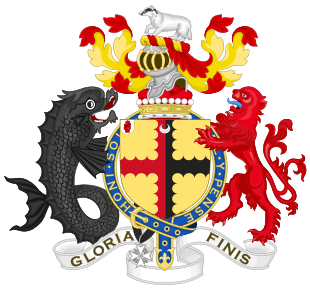
A left (sinister) Red Hand is an option for baronets to add to their arms to indicate their rank. The College of Arms formally allowed this in 1835, ruling that the baronets of England, Ireland, Great Britain or the United Kingdom may "bear either a canton in their coat of arms, or in an escutcheon, at their pleasure, the arms of Ulster (to wit) a Hand Gules or a Bloody Hand in a Field Argent."[47] It is blazoned as follows: A hand sinister couped at the wrist extended in pale gules.[48]
King James I of England established the hereditary Order of Baronets in England on 22 May 1611, in the words of Collins (1741): "for the plantation and protection of the whole Kingdom of Ireland, but more especially for the defence and security of the Province of Ulster, and therefore for their distinction those of this order and their descendants may bear (the Red Hand of Ulster) in their coats of arms either in a canton or an escutcheon at their election".[48] Such baronets may also display the Red Hand of Ulster on its own as a badge, suspended by a ribbon below the shield of arms.[49] Baronets of Nova Scotia, unlike other baronets, do not use the Red Hand of Ulster, but have their own badge showing the Royal Arms of Scotland on a shield over the Saltire of St Andrew.[47] The left-hand version has also been used by the Irish National Foresters, the Irish Citizen Army and the Federated Workers' Union of Ireland.
Examples
 The flag of the province of Ulster
The flag of the province of Ulster Four Provinces Flag of Ireland
Four Provinces Flag of Ireland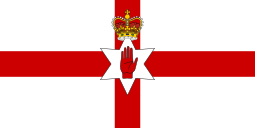 The flag of the Northern Ireland parliament (1953–1972)
The flag of the Northern Ireland parliament (1953–1972) Badge worn by baronets of the United Kingdom
Badge worn by baronets of the United Kingdom- Seal with left hand for the Curtius baronets
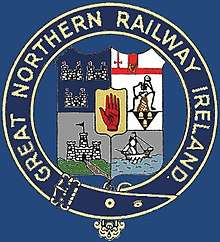 The coat of arms of the GNR.
The coat of arms of the GNR. Republican National Graves Association, Belfast
Republican National Graves Association, Belfast Arms of O'Neill Hall at the University of Notre Dame
Arms of O'Neill Hall at the University of Notre Dame
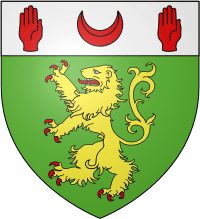 Arms of McCartan, a branch of the Magennis
Arms of McCartan, a branch of the Magennis
Bibliography
- Barry, E. (1895). "On Ogham-Stones Seen in Kilkenny County". The Journal of the Royal Society of Antiquaries of Ireland. Fifth Series. Royal Society of Antiquaries of Ireland. 5 (4): 348–368.
- Bergin, Osborn (1925). "Unpublished Irish Poems. XXIX: On Cathal Redhand". Studies: An Irish Quarterly Review. Irish Province of the Society of Jesus. 14 (53): 61–65.
- Bigger, Francis J. (1902). "The Dextera Dei Sculptured on the High Crosses of Ireland". Proceedings of the Royal Irish Academy (1889–1901). Royal Irish Academy. 6 (1900–1902).
- Burke, Bernard (1884). The General Armory of England, Scotland, Ireland, and Wales, Comprising a Registry of Armorial Bearings from the Earliest to the Present Time. Heritage Books – via Internet Archive.
- Burtchaell, G. D. (1902). "Badge of the Royal Society of Antiquaries of Ireland". The Journal of the Royal Society of Antiquaries of Ireland. Fifth Series. Royal Society of Antiquaries of Ireland. 32 (4): 415–418.
- Cavanagh, Cathal (2006). "Miscellaneous Stories of Caomhánachs in Exile". The Past: The Organ of the Uí Cinsealaigh Historical Society. Uí Cinsealaigh Historical Society (27): 96–105. doi:10.2307/25520125. JSTOR 25520125.
- Fitzpatrick, Elizabeth (2004). Royal Inauguration in Gaelic Ireland C. 1100–1600: A Cultural Landscape Study. Boydell Press. ISBN 9781843830900.
- Duffy, Seán (2005). Medieval Ireland An Encyclopedia. Routledge. ISBN 0-415-94052-4.
- Hamilton, G. A. (1844). "On "A North House," in the Demesne of Hampton, and the Opening of a Tumulus near Knockingen". Proceedings of the Royal Irish Academy (1836-1869). 3 (1844–1847). Royal Irish Academy. pp. 249–252.
- Keating, Geoffrey (1723). The General History of Ireland. J. Bettenham.
- Keating, Geoffrey (1983). Keating's History of Ireland. Irish Genealogical Foundation. ISBN 978-0-686-44360-5.
- M., M. (1901). "The "Three Waves" of Ancient Erin". All Ireland Review. 2 (24): 184–185. doi:10.2307/20545459. JSTOR 20545459.
- McManus, Damian (2013). "Surnames and Scions: Adjectival Qualification of Christian Names and Cognomina in Classical Irish Poetry". Ériu. Royal Irish Academy. 63, pp. 117–143.
- Ó Cróinín, Dáibhí (1995). Early Medieval Ireland 400–1200. Longman.
- O'Curry, Eugene (2010). On the Manners and Customs of the Ancient Irish, III. Kessinger Publishing. ISBN 978-1163577769.
- O'Daly, John; O'Donovan, John (1853). "Inauguration of Cathal Crobhdhearg O'Conor, King of Connaught". Transactions of the Kilkenny Archaeological Society. Royal Society of Antiquaries of Ireland. 2 (2): 335–347.
- O'Neill, The (1908). "The Heraldic Emblem of Ireland". Ulster Journal of Archaeology, Second Series. Ulster Archaeological Society. 14 (4): 178–180.
- Ó Riain, Gordon (2011). "VARIA III. Quatrains relating to the controversy of the Red Hand". Ériu. Royal Irish Academy. 61: 171–178.
- Ó Riain, Gordon (2013). "VARIA I". Ériu. Royal Irish Academy. 63: 145–153.
- Schlegel, Donald M. (2002). Reweaving the Tapestry of Ancient Ulster. Clogher Record. Clogher Historical Society. p. 747-9.
- Shearman, J. F. (1877). "Loca Patriciana: Part XI. St. Patrick's Progress into Ossory-Disertum Patricii, Martartech in Magh Roighne – Patrician Missionaries in Ossory, Their Churches, Killamorey: St. Ciaran,First Bishop and Patron of Ossory: His Period, &c., &c.: Notices of Some Saints of the Raceof the Ossorians". The Journal of the Royal Historical and Archaeological Association of Ireland. Fourth Series. Royal Society of Antiquaries of Ireland. 4 (29): 188–245.
- Welsh, Robert (1996). Oxford Concise Companion to Irish Literature. ISBN 0-19-280080-9.
- Westropp, Thomas Johnson (1918). "The Earthworks, Traditions, and the Gods of South-Eastern Co. Limerick, Especially from Knocklong to Temair Erann". Proceedings of the Royal Irish Academy: Archaeology, Culture, History, Literature. Royal Irish Academy. 34: 127–183. doi:10.2307/25504213.
- Williams, N. J. A. (1990). "Dermot O'Connor's Blazons and Irish Heraldic Terminology". Eighteenth-Century Ireland / Iris an dá chultúr. Eighteenth-Century Ireland Society. 5: 61–88.
- Vallancey, Charles (1788). "Description of an Ancient Monument in the Church of Lusk in the County of Dublin". The Transactions of the Royal Irish Academy. Royal Irish Academy. 2: 57–68.
- M., Y. (1901). "Annals of the Four Masters". All Ireland Review. 2 (14): 102–103.
References
- "Irish Ancestors /Heraldic traditions". The Irish Times.
- Schlegel (2002), pp. 747–9
- Duffy (2005), p. 231
- Duffy (2005), p. 481
- John Cornelius O'Callaghan. "History of the Irish Brigades in the service of France". Cameron and Ferguson.
- National Library of Ireland Heraldry In Ireland
- Ó Riain (2013), pp. 147–8
- Dublin Institute for Advanced Studies – 1185. Lamh dhearg Eireann Uibh Eathach; Dr Katharine Simms, Department of History, Trinity College Dublin
- McManus (2013), p. 122
- Ó Cróinín (1995), p. 48
- Place Names NI. "Iveagh". Retrieved 1 September 2017.
- University College Cork – Early Irish Population-Groups: Their Nomenclature, Classification, and Chronology. Section 3, Sept-Names
- O'Neill (1908), p. 179
- Burtchaell (1902), p. 418
- Keating (1983), p. 728
- Ó Riain (2011), p. 171
- Williams (1990), p. 64
- Welsh (1996)
- O'Neill (1908), p. 180
- Bigger (1925), pp. 79–84
- Ó hÓgáin, Dáithí. Myth, Legend & Romance: An encyclopaedia of the Irish folk tradition. Prentice Hall Press, 1991. pp.36-37
- O'Curry (2010), pp. 78–94
- Schlegel (2002), p. 728
- M. (1901a), p. 184
- M. (1901b), p. 102
- Eriksen, Thomas Hylland; Jenkins, Richard (2007). Flag, Nation and Symbolism in Europe and America. Routledge. p. 81. ISBN 978-1-134-06696-4.
- The Red Hand of Ulster
- Westropp (1918), pp. 145–7
- Westropp (1918), p. 134
- Barry (1895), p. 365
- "Search Results for Labraid Lámderg". Oxford Reference.
- Keating (1723), p. 157
- O'Daly & O'Donovan (1853), p. 337
- Bergin (1925), pp. 61–65
- Hamilton (1844), p. 252
- Burke (1884), p. 552
- Cavanagh (2006), p. 100
- McManus (2013), p. 120
- Fitzpatrick (2004), p. 65
- Shearman (1877), p. 209
- Vallancey (1788), p. 59
- Williams (1990), p. 68
- "O Neill, Neill, Neale, Neil". Araltas.com.
- Burke's Peerage, London 2003, sub "Iveagh"
- "Wars and Conflicts – Plantation of Ulster – English and Scottish Planters – The London Companies". BBC.
- Mosley, Charles, ed. (2003). Burke's Peerage, Baronetage & Knighthood (107 ed.). Burke's Peerage & Gentry. p. 524. ISBN 0-9711966-2-1.
- Pixley, F.S.A, Francis W. (2016) [1900]. A History of The Baronetage. pp. 262–269. ISBN 9780956815750. Retrieved 6 July 2017.
- Collins, Arthur, The English Baronetage: Containing a Genealogical and Historical Account of all the English Baronets now Existing, Volume 4, London, 1741, p.287
- Debrett's Peerage, 1968, p.1235